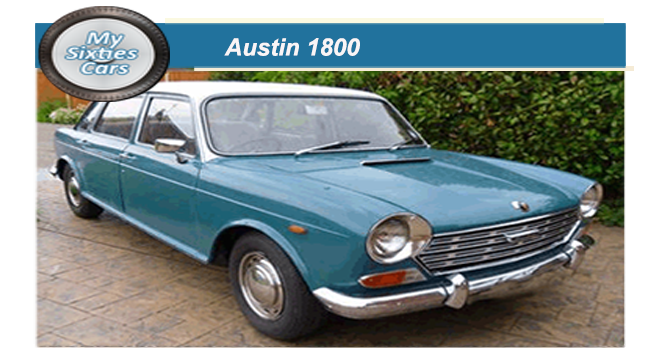
The first third-generation front wheel drive to come out of the BMC stable was the Morris 1800, first launched in 1964.
As was the way with BMC in the Sixties, the Morris 1800 soon spawned off its derivatives this time Morris and Wolseley versions only.
Except for its grille, badging, and tiny details of its equipment, the Austin 1800 was always the same car as the Morris 1800.
The only real difference, in this case, was that the Morris had been launched in October 1964, while the Austin first appeared in March 1966.
Like the Morris, the Austin 1800 became Mk II in May 1968, but at least the higher performance (96bhp) the 1800S appeared first, in October 1968.
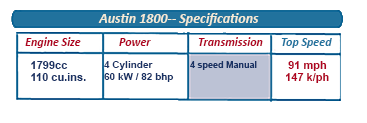
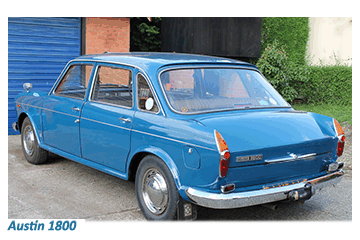 The Austin 1800 was another product of the Sir Alex Issigonis design studio at BMC, and there was no escaping the resemblance to the Mini and the 1100/1300 models.
The Austin 1800 was another product of the Sir Alex Issigonis design studio at BMC, and there was no escaping the resemblance to the Mini and the 1100/1300 models.
Once again displaying the Issigonis trademark of bland yet functional styling, with the the Austin 1800 interior also being pretty spartan.
All that was on offer in the way of interior trim was a full-width parcels shelf with air vents, a passenger's side sun visor, full carpeting, hinged quarter-lights and wheel trim and a rear-seat centre armrest.
However, the Austin Maxi faced a number of issues that impacted its reputation. Quality control problems, reliability issues, and inconsistent build quality were some of the concerns reported by owners. These factors, along with its somewhat unconventional styling, influenced its perception in the market.
In terms of performance, the Maxi was not known for being particularly sporty or powerful. It was designed more as a practical and economical family car, with a focus on everyday usability rather than high performance.
![]()
Despite these possible shortcomings, the Austin 1800 was well received when it first came on the market even winning the Car of the Year award for 1964.
Most of the parts used in building the 1800, were little more than scaled-up versions of those on the 1100/1300, lending weight to industry speculation that the stable siblings were just too identical for comfort. Despite their strong similarities, the two models shared not a single universal part.
T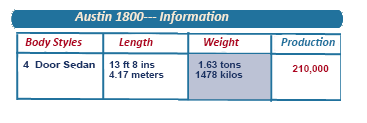 hroughout its decade-long production run, the 1800 was powered by the same engine, a transverse 1798cc B-Series engine linked up to a manual 4-speed gearbox, with an internal sump layout.
hroughout its decade-long production run, the 1800 was powered by the same engine, a transverse 1798cc B-Series engine linked up to a manual 4-speed gearbox, with an internal sump layout.
Power-assisted steering became optional in 1967 which must owners insisted was not before time as the 1800 was a massive car to handle, especially in urban driving situations.
Another update that came with the release of the Mark II version in 1968 was AP automatic transmission, although available only as an optional extra.
![]()
Apart from the automatic option, it would be almost impossible to differentiate between the Mark I and II.
The Austin 1800 was designed to be a workhorse, structure, and dependable, but somewhat stodgy to drive, it
D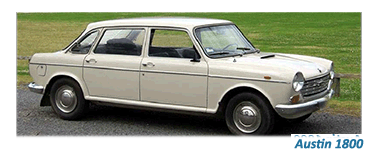 espite being a larger than average car, the 1800 was planned to fit neatly into a niche in the market that BMC's logistics team had recognised.
espite being a larger than average car, the 1800 was planned to fit neatly into a niche in the market that BMC's logistics team had recognised.
Unfortunatley, it soon transpired that the niche the 1800 was supposed to fill was nowhere near as large as BMC projected, with less that three hundred thousand Austin 1800's sold during its production period.
Even more difficult to explain was that the almost identical Morris version, sold sround half of that amount!
The Austin Maxi is often remembered as a car with innovative ideas but plagued by execution issues. While it introduced some features that were ahead of its time, the overall build quality and reliability problems affected its reputation. As a result, it didn't achieve the same level of success or recognition as some of its contemporaries. In conclusion, the Austin Maxi had both positive and negative aspects. Its innovative features were overshadowed by quality and reliability issues, leading to a mixed reputation in the automotive world.





